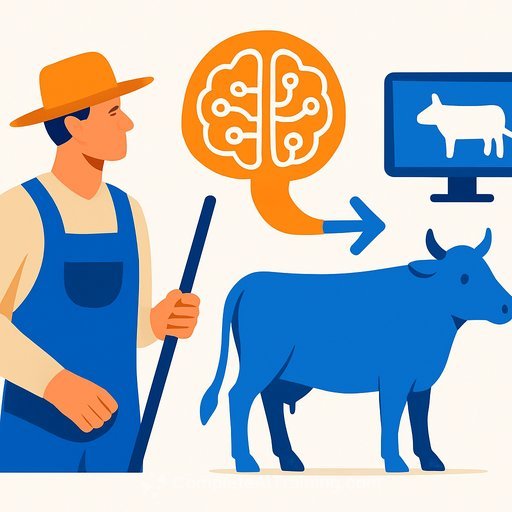Farmers must be at the heart of AI system development
At AI(Live), the UK's first conference dedicated to AI in livestock farming, the message was clear: farmers need to co-drive how systems are built if we want real outcomes on the ground. Around 300 attendees from industry bodies, government, software companies, academia, and farms aligned on one priority-design with farmers, not just for them.
As one speaker put it, "Every farm and every farmer is unique… farming is far too important to leave to the tech giants. Farmers must understand and influence AI development and must see an ROI on systems they use." That sets a practical bar for product teams: measurable gains, simple workflows, and tools that fit the day-to-day reality of a working farm.
Adoption snapshot
A survey released at the event showed a gap between data use and true AI deployment. While 52% of farmers regularly use data, only 10% are using AI for decisions or operations. Trust, cost, reliability, and data security are the biggest blockers. 57% want more education and training.
- Implication for product teams: reliability beats novelty. Prove stability, uptime, and savings before scaling features.
- Security and ownership must be explicit. Farmers want clarity on who sees what and how it's used.
- Training is part of the product. Plan onboarding, refreshers, and on-farm support-not just docs.
Build for the farm first: technical priorities
- Offline-first and low-bandwidth design. Assume patchy connectivity and sync in bursts. Cache locally, queue tasks, fail gracefully.
- Edge inference for time-critical tasks. Process video and sensor data on-device or near-farm to cut latency and bandwidth.
- Interoperability with existing tools. Provide clean APIs and support common formats used by herd and vet systems.
- Simple, explainable outputs. Show confidence, top factors, and recommended next steps. No black boxes for high-stakes calls.
- Human-in-the-loop by default. Let farmers and vets confirm, edit, or override predictions to improve models and trust.
- Auditable data flows. Log data source, model version, and decision trace for each alert or action.
- Role-based UX. Different views for farm owners, vets, and farmhands with the minimum actions needed per role.
Trust isn't a feature-make it systemic
- Clear data contracts: ownership, sharing scope, retention, and deletion policies visible in-app.
- Transparent model updates: notify users when models change and what that means for accuracy.
- Safety rails: confidence thresholds, second-step verification for costly actions, and easy rollback.
- Baseline first: compare AI outputs to current farmer practice and simple rules to prove incremental value.
Prove ROI with narrow, high-value use cases
- Start with a single pain point (e.g., early lameness detection, heat detection, feed optimization, calving alerts).
- Define success upfront: fewer vet visits, reduced mortality, faster detection-to-action time, or hours saved per week.
- Show payback in months, not years. Price against savings and risk reduction.
- Integrate into daily routines. Reduce clicks, automate data capture, and fit the farm's existing workflows.
Infrastructure still decides outcomes
Inclusive access matters. Rural broadband is the backbone for data sync, remote updates, and support. Keep solutions usable offline, but advocate for better connectivity. For context on UK rollout plans, see the government's Project Gigabit initiative: Project Gigabit.
Who's involved
The conference brought together industry bodies, government, developers, academics, vets, and farmers to set priorities for livestock AI. Sponsors included HerdVision, VetImpress, Vetoquinol, OvaCyte, MSD Animal Health, IVC Farm Vets, Herdwatch, and Kynetec.
One organizer summed it up: AI spans every part of farm businesses, but the sector must lead development, educate users, support deployment, and build trust.
What to build next
- API-first data exchange across herd management, sensors, and vet platforms.
- Edge-ready models with remote update pipelines and rollback.
- Model monitoring: drift detection, false positive tracking, and feedback loops from farmer corrections.
- On-farm labeling tools to turn real use into better training data.
- Device-agnostic mobile apps with offline queues and event-driven sync.
Upskilling and support
With 57% of farmers asking for training, pair software rollouts with simple playbooks, short videos, and field visits. If you're building or deploying these systems and want structured learning paths, explore role-based AI courses here: Complete AI Training: Courses by Job.
Bottom line: co-design with farmers, solve one painful problem well, make it work offline, explain your decisions, and measure ROI in plain numbers. That's how AI will earn its place on the farm.
Your membership also unlocks:






